Burning the Midnight Oil for Living Energy Independence
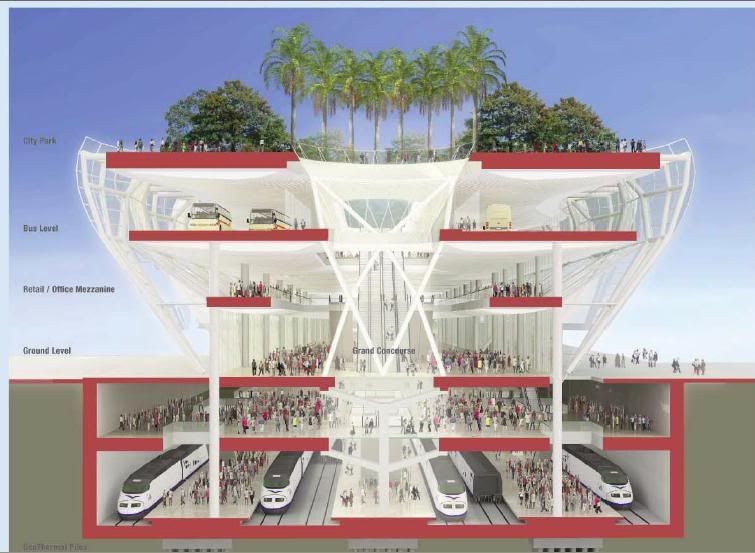 In Part 1, the testimony representing the Transbay Joint Power Authority, managing the Transbay project, resulted in such a pile of red herring left behind that it seemed that there was something fishy going on.
In Part 1, the testimony representing the Transbay Joint Power Authority, managing the Transbay project, resulted in such a pile of red herring left behind that it seemed that there was something fishy going on.What that something fishy seemed to be was whether the Transbay Terminal "train box" was suited for serving as the main northern terminus for both California High Speed Rail (HSR) services and for Caltrain services.
An effort was made in part 1 to squeeze the California High Speed Rail Authority's requested turn-around time into the confines of the TBT "train box". As a design exercise, it seemed that it might be remotely possible, but doing so would put Caltrain onto short platforms that would limit its opportunity for future growth in patronage.
In Part 2, I looked more closely at the CHSRA request, and argued that if four HSR platform tracks, plus two Caltrain platform tracks, is not enough ... then six HSR platform tracks, plus two Caltrain platform tracks, ought to be. I looked at two alternatives for the train box.
But ... what if the Transbay Terminal is not the terminus of the HSR services?
Terminal Versus Terminus: A Critical Distinction
Thanks to Richard Mlynarik commenting at the Focus on: SF Transbay Transit Center post (Caltrain HSR Compatibility Blog), real world European performance at busy terminal stations can be compared to the CHSRA request. Here's a snapshot of individual trains "that pass though the stub-end Frankfurt (am Main) main station (Hauptbahnhof)" ... "ICE" is the German HSR service, the number after that is the specific service number, then the platform number, then the arriving time, then the departing time:
ICE 824 10 06:56 07:02
ICE 874 8 07:08 07:13
ICE 2273 13 07:33 07:38
ICE 2028 7 07:36 07:42
ICE 591 9 07:44 07:50
ICE 525 6 07:48 07:54
ICE 670 8 07:52 07:58
In practice, they use five different platforms, but that's because they have common platform heights for their commuter services and their HSR services, so they can do things like bring make a connection between a regional rail service and an HSR service across the same platform island.
Still, looking at the schedule, even if the required separation inside the TBT is nine minutes ... three minutes separation, six minutes spare to avoid delays at one service from cascading across the schedule ... then the above schedule could still run on three platforms:
ICE 874 A 07:08 07:13 ... A will be available at 7:22
ICE 2273 B 07:33 07:38 ... B will be available at 7:47
ICE 2028 C 07:36 07:42 ... C will be available at 7:51
ICE 591 A 07:44 07:50 ... A will be available at 7:59
ICE 525 B 07:48 07:54 ... B will be available at 8:03
ICE 670 C 07:52 07:58 ... C will be available at 8:07
How do they do in Germany what the CHSRA thinks is impossible? By not ending the service at the busy platform. Instead, the busy platform has people waiting to get on as soon as arriving passengers has debarked ... just like at a through platform. Sure, all the people arriving will be debarking, and all the leaving on the train will be getting on at that station ...
... but this is not clearing out the train, restocking the food and drinks, doing end of service safety checks, then letting passengers onto the platform to board the train. Instead, its just passengers debark, passengers embark, and the train goes.
The services, in other words, terminate or originate somewhere else. A train coming into service in the early morning can be brought in ready to go from the service center. When a train goes out of service late in the evening, it can head off to the service center. But in the busy period, the trains come from somewhere else, and then head off again.
In short, economize on the expensive underground platform space, and do the more time consuming service terminus operations somewhere else.
Problem solved ... yes? Maybe Not? WHAT'S THE PROBLEM NOW?
Now, does that fix the problem? Well, yes and no.
Yes, it fixes the problem of the number of platforms. Ten minutes to embark and debark, and even with nine minutes slack to avoid a "domino effect" from delays, and four terminal platforms is enough platform capacity to serve twelve non-terminating services.
And if, as argued in Part 2, demand for a capacity to serve 8 HSR services is reasonable, an ability to serve 12 HSR services is room to spare.
But ... close one problem, and another problem opens up.
If the TBT is no longer the terminus of the services ... then that means it is in the middle of HSR service schedules. It might be the physical end of the line, but the solution to the platform problem means that services past through it. So it is within the HSR network of services. And that means it cannot duck out on the requirements for parts of the HSR network.
And in November of 2008, California Voters passed 2008-Prop1A (pdf), which says, in part:
The high-speed train system to be constructed pursuant to this chapter shall be designed to achieve the following characteristics:
...
(c) Achievable operating headway (time between successive trains) shall be five minutes or less."
What is a "headway". When the front ("head") of a train passes a point, how much time has to pass until the head of the next train is allowed to pass the same point? That's the headway.
Safe operating headways are mainly made up of two parts ... the time it takes for the train to pass, and the safe stopping distance for the following train. The faster the trains are running, the more its safe stopping distance that matters ... the slower the trains are running, the more its the time required to physically get the tail of the train past the point that matters.
At 220mph, even a full length, quarter of a mile long train is there and gone in a flash, and headways are mostly a matter of safe stopping distance. But when a full length HSR train is creeping along, getting that quarter of a mile of train past a point can take a noticeable period of time.
One thing had to be stressed. Headways are not averages, they are minimum time separations. The Transbay project people are getting making a lot of noise and getting a lot of political allies to make fun of the idea of twelve HSR trains per hour. And, indeed, I think it was probably a serious public relations blunder of the CHSRA to make their demand in terms of "you need to give us the facilities to terminate twelve trains per hour".
However, 2008-Prop1A Says that even if there are only three trains per hour, the network has to be designed to allow the second train five minutes after the first, and the third train five minutes after the second. If the Transbay Joint Power Authority wants to ask for HSR money to help build their train box ... they better be able to show they can support 5 minute headways for HSR.
Even more than the funding, there was a local San Francisco proposition passed in 1999, Proposition H, which specifies the TBT as the San Francisco terminal for High Speed Rail. So, arguably, if the TBT train box design does not meet the Prop 1A headway requirement, which rules it out of being a part of the HSR network, that is violating local statute, in addition to the risk to its chances of HSR stimulus funding.
Now, I'm not a rail engineer, so I cannot say for sure that they cannot show 5 minute headways ... but they sure as hell have made their job hard by putting together such a poor design for their train box.
Transbay: how not to design an underground train station
Most of the rest of this I draw from Clem's post on the Caltrain HSR Compatibility Blog, Focus on: SF Transbay Transit Center, and I highly recommend anyone interested in the issue read the post. Clem notes three things that a rail operator wants from a train station:
We can draw up a simple list of three key requirements for a good terminal station design:
1. High train throughput. By definition, all trains arriving at a terminus must reverse direction. The station must be able to turn back trains at the highest possible rate; otherwise, the station itself becomes a worse bottleneck than the tracks leading to it.
2. High passenger throughput. The flows of passengers into and out of trains must be made as simple and direct as possible. This involves an optimization of street access, ticketing facilities, and vertical access to station platforms. Limited and circuitous passenger throughput can become a bottleneck at peak hours.
3. Operational flexibility. The station must provide flexibility to adjust service patterns in response to real-time conditions. It must degrade gracefully in the event of a service disruption, minimizing the possibility of cascading delays.
... and then notes that the TBT train box design falls down on all three points. The focus of the Among those, here are a few of the most critical points in terms of throughput, which is the focus of the headway question:
Throat Cancer. The TJPA station throat design is a bottleneck that promises low speeds, long traversals and frequent conflicts (when a key piece of track is occupied by one train, preventing other trains from passing.) The train throughput of a station throat, which sets a limit on the throughput of the station itself, is related to its overall length (shorter is better), train speeds (higher is better) and most importantly, topology (track switches thoughtfully laid out to allow conflict-free parallel moves.) The station throat begins a full 3/4 mile (1150 m) from the end bumpers, causing trains to occupy the throat for far longer than necessary and increasing the delay required for a platform to be re-occupied by the next arriving train, thus limiting train throughput. The station throat does not allow simultaneous arrivals and departures from most platforms (such conflict-free parallel moves are the holy grail of throat design because they minimize the re-occupancy delay), severely limiting train throughput and operational flexibility.
...
Extremely Tight Curves. While curve radii at the location of the TTC itself are dictated by the street grid and surrounding building foundations, the two curves in the DTX tunnel approach (to turn from 7th onto Townsend and from Townsend onto 2nd) are much sharper than they need to be, and beyond the capability of some off-the-shelf high speed trains. High speed trains aren't MUNI street cars and won't turn on a dime; they are longitudinally stiff to provide good stability at high speeds. At these two curves on the 1.5-mile approach to the station, the radius could be easily increased from 150 m to at least 200 m, saving 30 to 40 valuable seconds in the long, slow crawl into the TTC, and increasing the train throughput of the station throat. If the throat can be straightened as well, a 200 m minimum radius would allow off-the-shelf procurement of trains without the need for expensive modifications to fit the extreme curves of the DTX, which threaten to set a standard for the entire California high speed rail system.
...
Inefficient 4th & Townsend Layout. The new underground station at 4th & Townsend should have four tracks to allow overtaking stopped trains in both directions (to improve train throughput) and its platforms should be lengthened to 400 m to allow HSR trains to use them in the event of a disruption at the TTC, thus improving operational flexibility to HSR and Caltrain's benefit.
To get a better handle on these problems, consider the following diagram of the "switching" system of the Downtown Tunnel Extension (click on picture for a full sized version):

Now, because Caltrain services and HSR services will have different platform heights, the side platforms at the "4th and Townsend" station (right hand of picture) will be only for the Caltrain services, up to six per hour, and one of the three islands at the end of the line (left hand side of picture) ... with a pair of platform tracks ... will be dedicated to Caltrain. Two terminal islands, with a total of four platform tracks, will be dedicated to HSR.
Quoting myself:
In the diagram, a Caltrain service departing either T-21 or T-22 will either crossover MT-2 at around +1050m or use the next switch to occupy MT-2 from there to +1720m, to allow an outbound HSR (not stopping at the local platform) to pass. In that case, an inbound HSR express can bypass a Caltrain inbound at the inbound platform on MT-2, then use the next switch to MT-5.
That is setting up that HSR to occupy MT-5 until the only switch back to the HSR platforms at about +900m. And of course the Caltrain local has to stay on MT-5 until the end.
I guess that means that MT-5 with a Caltrain inbound is a critical path. After the passing HSR uses the 2/5 switch at +1800m, how many minutes until the Caltrain local at the platform gets its green light and then passes by that switch, how many minutes until a following HSR can use / pass by that switch, and then how many minutes until an HSR passing the next local at the platform.
On the strictest reading of Prop 1A, the passing HSR and a following HSR can be five minutes apart and the Caltrain local has to fit in between ... on a more flexible reading, if two HSR are through and its clear for a third to pass inside of ten minutes, that would be close enough.
Now, an HSR outbound passing a Caltrain local outbound so the Caltrain local can use the outbound platform ... I got that. But an HSR outbound five minutes later would want to be on MT-2 all the way to pass. That's going to occupy MT-2 either all the way or from +700m to the 2/4 switch at +2450.
So that pins down the inbound pattern on MT-5. An inbound HSR uses MT-2 to pass a Caltrain local at the 4th and King platform on MT-5. Then the local pulls out of the platform. Then the following HSR uses the 2/5 switch at 2450 so that MT-2 is open for an outbound HSR passing a Caltrain local on the outbound platform, and chases the Caltrain Local up MT-5.
And ten minutes or less after the first passing HSR switched onto MT-5, another passing HSR must be clear to switch onto MT-5.
On a strict reading of the Prop 1A headway requirement, the headways inside the tunnel have to be two and a half minutes, to allow a Caltrain service to slot in between two HSR services that are running five minutes apart. And because of the design at 4th and Townsend of only one express track, alternating between inbound and outbound use, they have a very rigid operating schedule to maintain both ways through 4th and Townsend if they hope to be able to accommodate two or three HSR in a row at five minute intervals ... as required to be part of the HSR network.
The TJPA staff claim that trains can run 30mph through their tunnel design, but they have very tight curves, and its not clear that they can maintain 30mph all the way through. And there is a lot of inflexibility in getting a service from a particular tunnel track to a particular platform track and then out again.
And that's where my ability to squeeze information out of that diagram runs out. But the point is, the TJPA has to be able to prove that they can. They need to put together the timing of the system with trains coming in, trains going out, and meet two and a half minute headways.
Mind You, a Good Design Could Probably Do It
Can it be done? Well, it seems like it can, just not with the design they are working with. The layout proposed by Richard Mlynarik (pdf) looks like it probably can meet the requirement. Since navigating a pdf composed of so many design layers is tricky, let me take snapshots of particular points of interest.

First, at 4th and Townsend, there are three through platforms, one passing track, and one terminating platform. When Caltrain locals are mixing with HSR services, Caltrain services would normally use two of the platforms, and the inbound HSR could pass by on the track by the island at the bottom of the platform. So when two platforms are in use, there are two platforms and two passing tracks.
So Richard's design seems to eliminate the 4th and Townsend bottleneck, allowing any HSR in either direction to pass any Caltrain local, at any point in time.
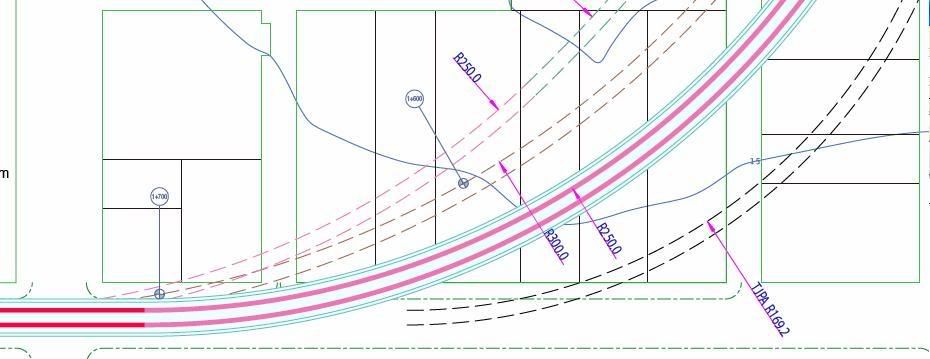
The next point is easy to overlook if you are just scanning the diagram, but its a critical point. High Speed Rail trains are not streetcars ... they need to be relatively stiff to have lateral stability when running at high speeds ... including when there is another HSR service on the next track over, running over 200mph the opposite direction. And those numbers are "turn radius" ... they describe the tightness of the curve in terms of the radius of a circle it would lie on.
The dotted black lines are the proposed TJPA design at the time Richard put together this layout, with a turn radius of 169.2m, or 555ft ... which is too tight for at least one of the HSR trains presently in operation, and tight enough to force many of them run relatively slowly in order to cope. In Richard's layout, those particular curves are loosened to 250m (820ft), and the tightest curve in his layout is 190m (623ft). Looser curves allow faster train operations, getting trains over switches more quickly.
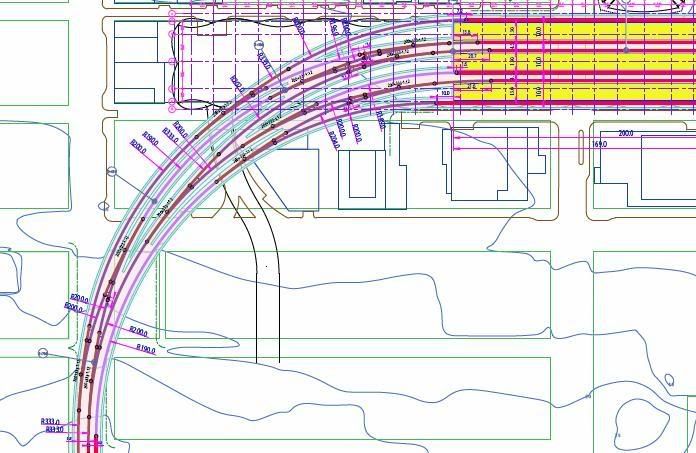
This complicated part is the station throat. The TJPA design simply extends the platform tracks around the curve, and does not start connecting them until it enters the tunnel. Richard's design allows more trains to be leaving platforms and arriving at platforms at the same time.

For the HSR platforms themselves, the platforms are all long enough for full length HSR trains, and the platforms are either straight or have a curve radius of 1000m (3,280ft), which allows the platforms to be built without a "gap" between the platform and the train. So if in the future, Caltrain services are upgraded to allow level wheelchair roll-on, roll-off boarding, the Caltrain platform can be upgraded to HSR heights, and the bottleneck of inflexible platform assignments can be eliminated as well.
Plus, it'd be cheaper too
This is the weird thing about design. With two equally good designs, "you get what you pay for". But one "feature" of a bad design is ... a lot of what you are paying for is coping with the bad design.
For the final point, don't focus on the switches ... count the tracks. These are the switches at opposite ends of the track underneath 2nd street:
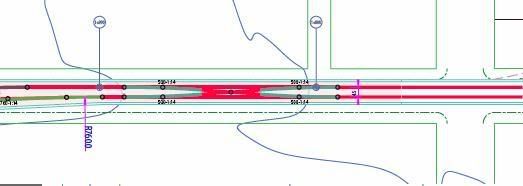
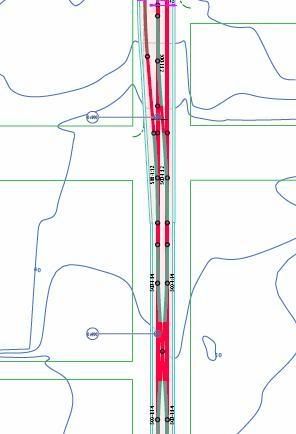
I count two. Is that what you got?
The thing is, all that the extra track the length of the tunnel provides is a way for HSR trains to pass local trains at 4th and Townsend. That's the only purpose it really serves if the system is being stretched to capacity ... and that, of course, is when it matters the most.
Since Richard's design makes the allowance for HSR trains to pass local trains at 4th and Townsend ... it doesn't need that extra tunnel track.
And tunneling costs money. Lots of money. So the TJPA design is an inflexible design that might not even qualify to be part of the HSR network in the first place. If it does, it imposes a very rigid schedule of operations during peak demand, so that any delay or problem is likely to affect the whole system.
Plus, it seems certain to cost more than a better design would do.
Back to the Coalition Building
Progressive politics is about coalition building. Richard's design costs less and would appear to meet the needs of both HSR services and of Caltrain services more effectively. So, there could well be a coalition of interests there.
Now, sure, the CHSRA could do the same analysis, come to the same conclusion, comes out counter-attacking hard on the "costs too much, does too little" line, and come from behind to win a propaganda war, where at the moment they are getting absolutely clobbered.
The prospects for that do not appear to be too strong, however. It seems very much as if the CHSRA is going to try to play hardball. Why, I am not sure ... perhaps it is an effort to make sure that none of the cost of the downtown extension tunnel and the TBT train-box is penciled in as "Federal money handed to California HSR". Perhaps they are long on civil engineering experience and short on train operating experience, and trying to throw concrete at the problems with the TJPA design under the "better safe than sorry" philosophy.
Ah, but Caltrain ... Caltrain has a lot riding on this project as well. Right now they are facing the headaches of expanding the Caltrain corridor through the towns of the Peninsula to accommodate HSR while electrifying and grade separating the whole corridor, to support their upgrade to electric passenger trains.
One third of their board is from the transit authority for the Peninsula, and a target for Peninsula NIMBY's roped in by HSR deniers ... they will want to see the TBT problem resolved as soon as possible with as little deep seated grudges as possible, if only to encourage a similar approach in the towns on the Peninsula along the Caltrain corridor.
One third of their board is from San Francisco, which is heavily invested in getting the TBT established as the main downtown intermodal transit center.
One third of their board is from the transit authority for San Jose and area, which wants to see the HSR service operating through downtown San Jose, wants to see effective Caltrain services, and are not likely to be heavily invested in the specifics of the San Francisco terminal.
It would seem to be a good thing for Caltrain all around if there is a solution to the TBT puzzle that:
- meets the legitimate needs of the CHSRA and respects the statutory requirements they are working under (even if it might not meet the full list of demands of the CHSRA);
- meets the needs of Caltrain better than the existing design;
- allows San Francisco to make a legitimate claim to fund part of the TBT train-box with HSR funds; and
- reduces the amount of money that San Francisco has to scrape together to build the Downtown Extension Tunnel.
And, in the end, while the TJPA certainly seems to be more into playing political games than seeking out quality design ... a solution that can recruit a broader coalition support is better for them as well.
So, unlike the Procrustrean Bed of the Part 1 Train Box design, and the trade-off in the Part 2 Train Box designs between tight fit and extra expense of different eight track, two-tier train boxes ... I'm happy enough with Richard Mlynarik to close the series here.
In other words, enough investigating the problem ... time to start rabble rousing.
And lest we forget why getting inter-regional transportation that can be powered by sustainable energy sources is so urgent ...
So we came and we conquered and found
Riches of commons and kings
Who strangled and wrestled the ground
But they never put back anything
Now I'm trapped like a dog in a cage
Wherever the truth is pursued
It must be the curse of the age
Whats taken is never renewed


1 comment:
This is a real pleasure to read !
I am an architect and urbanist from a daughter company of French railways SNCF (the ones who run the TGV train in France). I had the chance to participate in the preparation of San Francisco Bay Area regional rail plan so I am slightly familiar with the Transbay Terminal subject. Continue pushing this subject. You could also introduce some thoughts about the second, HSR rail including, bay tube going to Oakland (in the context of your arguments concernig the terminus vs through station operation scenario) and add a few thoughts about where the local maintenance yard (for night overlay etc) might be - if you find the proposed one to start with ...
Post a Comment